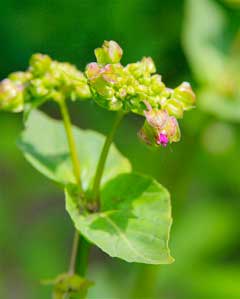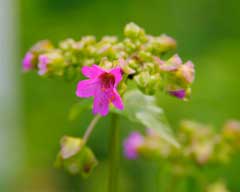 |
|
www.flickr.com/photos/8583446@N05/ |
 |
| www.flickr.com/photos/8583446@N05/ |
Translate this page:
Summary
Physical Characteristics

 Mirabilis nyctaginea is a PERENNIAL growing to 1 m (3ft 3in).
Mirabilis nyctaginea is a PERENNIAL growing to 1 m (3ft 3in).
See above for USDA hardiness. It is hardy to UK zone 8 and is frost tender. It is in flower from July to August. The species is hermaphrodite (has both male and female organs).
Suitable for: light (sandy), medium (loamy) and heavy (clay) soils and prefers well-drained soil. Suitable pH: mildly acid, neutral and basic (mildly alkaline) soils. It can grow in semi-shade (light woodland) or no shade. It prefers moist soil.
UK Hardiness Map
US Hardiness Map
Synonyms
Oxybaphus nictagineus.
Plant Habitats
Cultivated Beds;
Edible Uses
References More on Edible Uses
Medicinal Uses
Plants For A Future can not take any responsibility for any adverse effects from the use of plants. Always seek advice from a professional before using a plant medicinally.
Vulnerary
The chewed root is used as a poultice for wounds, burns, sores, sprains etc[207, 222, 257]. A tea made from the roots is also used to treat burns, fevers and to expel worms[213, 222, 257]. A tea made from the leaves or the roots is used in the treatment of bladder ailments[222]. Caution is advised in the use of this plant internally, see notes above on toxicity.
References More on Medicinal Uses
The Bookshop: Edible Plant Books
Our Latest books on Perennial Plants For Food Forests and Permaculture Gardens in paperback or digital formats.

Edible Tropical Plants
Food Forest Plants for Hotter Conditions: 250+ Plants For Tropical Food Forests & Permaculture Gardens.
More

Edible Temperate Plants
Plants for Your Food Forest: 500 Plants for Temperate Food Forests & Permaculture Gardens.
More

More Books
PFAF have eight books available in paperback and digital formats. Browse the shop for more information.
Shop Now
Other Uses
References More on Other Uses
Cultivation details
Requires a fertile well-drained soil in full sun or part-day shade[200]. Plants flower in their first year from seed and, although they are not very hardy in Britain, they can either be grown as half-hardy annuals or the tubers can be harvested in the autumn and stored overwinter in a cool frost-free place in much the same manner as dahlias[200]. Members of this genus are rarely if ever troubled by browsing deer[233].
References Carbon Farming Information and Carbon Sequestration Information
Temperature Converter
Type a value in the Celsius field to convert the value to Fahrenheit:
Fahrenheit:
The PFAF Bookshop
Plants For A Future have a number of books available in paperback and digital form. Book titles include Edible Plants, Edible Perennials, Edible Trees,Edible Shrubs, Woodland Gardening, and Temperate Food Forest Plants. Our new book is Food Forest Plants For Hotter Conditions (Tropical and Sub-Tropical).
Shop Now
Plant Propagation
Seed - sow spring in a greenhouse. When they are large enough to handle, prick the seedlings out into individual pots and plant them out in early summer, after the last expected frosts. The seed remains viable for several years[196]. Division in spring as the plant comes into growth[200].
Other Names
If available other names are mentioned here
Native Range
NORTHERN AMERICA: Canada (Québec, Ontario, Saskatchewan (south), Alberta (south), Manitoba, British Columbia (south)), United States (Connecticut, Indiana, Maine, Massachusetts, Michigan, New Hampshire, New Jersey, New York, Ohio, Pennsylvania, Rhode Island, Vermont, West Virginia, Iowa, Kansas, Minnesota, Missouri, Nebraska, North Dakota, South Dakota, Illinois, Oklahoma, Wisconsin, Colorado (east), Idaho, Montana, Oregon, Washington, Wyoming (east), Alabama, Arkansas, Delaware, District of Columbia, Kentucky, Louisiana, Maryland, North Carolina, Tennessee, Virginia, New Mexico (east), Texas, Arizona, California, Nevada, Utah), Mexico (Coahuila de Zaragoza, Sonora, Zacatecas, Aguascalientes, Guanajuato, Hidalgo, Jalisco, Oaxaca, Puebla, Querétaro, Veracruz de Ignacio de la Llave)
Weed Potential
Right plant wrong place. We are currently updating this section.
Please note that a plant may be invasive in one area but may not in your area so it's worth checking.
Conservation Status
IUCN Red List of Threatened Plants Status :

Growth: S = slow M = medium F = fast. Soil: L = light (sandy) M = medium H = heavy (clay). pH: A = acid N = neutral B = basic (alkaline). Shade: F = full shade S = semi-shade N = no shade. Moisture: D = dry M = Moist We = wet Wa = water.
Now available:
Food Forest Plants for Mediterranean Conditions
350+ Perennial Plants For Mediterranean and Drier Food Forests and Permaculture Gardens.
[Paperback and eBook]
This is the third in Plants For A Future's series of plant guides for food forests tailored to
specific climate zones. Following volumes on temperate and tropical ecosystems, this book focuses
on species suited to Mediterranean conditions—regions with hot, dry summers and cool, wet winters,
often facing the added challenge of climate change.
Read More
Expert comment
Author
Michx.
Botanical References
200274
Links / References
For a list of references used on this page please go here
Readers comment
| Add a comment |
|
If you have important information about this plant that may help other users please add a comment or link below. Only comments or links that are felt to be directly relevant to a plant will be included. If you think a comment/link or information contained on this page is inaccurate or misleading we would welcome your feedback at [email protected]. If you have questions about a plant please use the Forum on this website as we do not have the resources to answer questions ourselves.
* Please note: the comments by website users are not necessarily those held by PFAF and may give misleading or inaccurate information.
To leave a comment please Register or login here All comments need to be approved so will not appear immediately.
|
Subject : Mirabilis nyctaginea
|
|
|
|